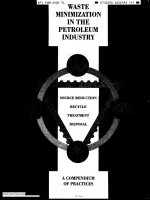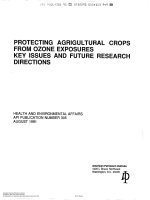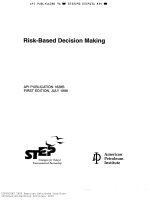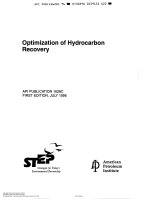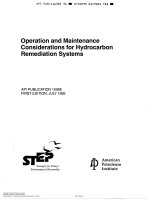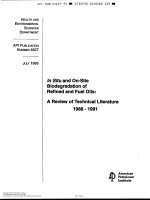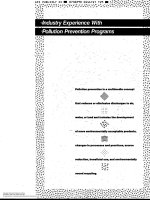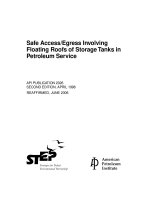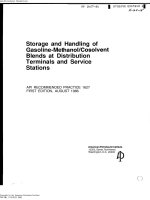Api publ 422 1994 scan (american petroleum institute)
Bạn đang xem bản rút gọn của tài liệu. Xem và tải ngay bản đầy đủ của tài liệu tại đây (814.12 KB, 17 trang )
~
~
A P I PUBLa422 9 4
~
0732270 0 5 3 9 1 2 2 T25
Groundwater Protection Programs
For Petroleum Refining and
Storage Facilities: A Guidance
Document
-
American Petroleum Institute
1220 L Street, Northwest
Washington, D.C. 20005
11'
Strategies for 'io1day 5
Environmental Partnership
Copyright American Petroleum Institute
Provided by IHS under license with API
No reproduction or networking permitted without license from IHS
Not for Resale
--`,,-`-`,,`,,`,`,,`---
API PUBLICATION 422
FIRST EDITION, OCTOBER 1994
A P I PUBL*:422 9 4
= 0732290 0 5 3 9 3 2 3 961
STEP
One of the most significant long-term trends affecting the future vitality of the petroleum
industry is the public’s concerns about the environment. Recognizing this trend, APT member companies have developed a positive, forward looking strategy called STEP: Strategies
for Today’s Environmental Partnership. This program aims to address public concerns by
improving industry’s environmental, health and safety performance; documenting performance improvements; and communicating them to the public. The foundation of STEP is
the API Environmental Mission and Guiding Environmental Principles. API standards, by
promoting the use of sound engineering and operational practices, are an important means
of implementing API’s STEP program.
API ENVIRONMENTAL MISSION AND GUIDING
ENVIRONMENTAL PRINCIPLES
The members of the American Petroleum Institute are dedicated to continuous efforts to
improve the compatibility of our operations with the environment while economically developing energy resources and supplying high quality products and services to consumers.
The members recognize the importance of efficiently meeting society’s needs and our responsibility to work with the public, the government, and others to develop and to use natural resources in an environmentally sound manner while protecting the health and safety
of our employees and the public. To meet these responsibilities, API members pledge to
manage our businesses according to these principles:
To recognize and to respond to community concerns about our raw materials, products
and operations.
To operate our plants and facilities, and to handle our raw materials and products in a
manner that protects the environment, and the safety and health of our employees and the
public.
To make safety, health and environmental considerations a priority in our planning, and
our development of new products and processes.
To advise promptly appropriate officiais, employees, customers and the public of information on significant industry-related safety, health and environmental hazards, and to
recommend protective measures.
To counsel customers, transporters and others in the safe use, transportation and disposal
of our raw materials, products and waste materials.
--`,,-`-`,,`,,`,`,,`---
To economically develop and produce natural resources and to conserve those resources
by using energy efficiently.
To extend knowledge by conducting or supporting research on the safety, health and environmental effects of our raw materials, products, processes and waste materials.
To commit to reduce overall emissions and waste generation.
To work with others to resolve problems created by handling and disposal of hazardous
substances from our operations.
To participate with government and others in creating responsible laws, regulations and
standards to safeguard the community, workplace and environment.
To promote these principles and practices by sharing experiences and offering assistance
to others who produce, handle, use, transport or dispose of similar raw materials, petroleum products and wastes.
Copyright American Petroleum Institute
Provided by IHS under license with API
No reproduction or networking permitted without license from IHS
Not for Resale
~~
A P I PUBLx422 74
m 0732290
0539324 8T8
Groundwater Protection Programs
For Petroleum Refining and
Storage Facilities: A Guidance
Document
Manufacturing, Distribution and Marketing Department
API PUBLICATION 422
FIRST EDITION, OCTOBER 1994
--`,,-`-`,,`,,`,`,,`---
American
Petroieum
Institute
Copyright American Petroleum Institute
Provided by IHS under license with API
No reproduction or networking permitted without license from IHS
Not for Resale
-
~
~
A P I P U B L U 4 2 2 94
~~
0732290 0 5 3 9 3 2 5 73q
SPECIAL NOTES
1. API PUBLICATIONS NECESSARILY ADDRESS PROBLEMS OF A GENERAL
NATURE. WITH RESPECT TO PARTICULAR CIRCUMSTANCES, LOCAL, STATE,
AND FEDERAL LAWS AND REGULATIONS SHOULD BE REVIEWED.
2. API IS NOT UNDERTAKING TO MEET THE DUTIES OF EMPLOYERS, MANUFACTURERS, OR SUPPLIERS TO WARN AND PROPERLY TRAIN AND EQUIP
THEIR EMPLOYEES, AND OTHERS EXPOSED, CONCERNING HEALTH AND
SAFETY RISKS AND PRECAUTIONS, NOR UNDERTAKING THEIR OBLIGATIONS
UNDER LOCAL, STATE, OR FEDERAL LAWS.
3. INFORMATION CONCERNING SAFETY AND HEALTH RISKS AND PROPER
PRECAUTIONS WITH RESPECT TO PARTICULAR MATERIALS AND CONDITIONS SHOULD BE OBTAINED FROM THE EMPLOYER, THE MANUFACTURER
OR SUPPLIER OF THAT MATERIAL, OR THE MATERIAL SAFETY DATA SHEET.
--`,,-`-`,,`,,`,`,,`---
4. NOTHING CONTAINED IN ANY API PUBLICATION IS TO BE CONSTRUED AS
GRANTING ANY RIGHT, BY IMPLICATION OR OTHERWISE, FOR THE MANUFACTURE, SALE, OR USE OF ANY METHOD, APPARATUS, OR PRODUCT COVERED BY LETTERS PATENT. NEITHER SHOULD ANYTHING CONTAINED IN
THE PUBLICATION BE CONSTRUED AS INSURING ANYONE AGAINST LIABILITY FOR INFRINGEMENT OF LETTERS PATENT.
5 . GENERALLY, API STANDARDS ARE REVIEWED AND REVISED, REAFFIRMED, OR WITHDRAWN AT LEAST EVERY FIVE YEARS. SOMETIMES A ONETIME EXTENSION OF UP TO TWO YEARS WILL BE ADDED TO THIS REVIEW
CYCLE. THIS PUBLICATION WILL NO LONGER BE IN EFFECT FIVE YEARS AFTER ITS PUBLICATION DATE AS AN OPERATIVE API STANDARD OR, WHERE
AN EXTENSION HAS BEEN GRANTED, UPON REPUBLICATION. STATUS OF THE
PUBLICATION CAN BE ASCERTAINED FROM THE API AUTHORING DEPARTMENT [TELEPHONE (202) 682-8000]. A CATALOG OF API PUBLICATIONS AND
MATERIALS IS PUBLISHED ANNUALLY AND UPDATED QUARTERLY BY API,
1220 L STREET, N.W., WASHINGTON, D.C. 20005.
Copyright O 1994 American Petroleum Institute
Copyright American Petroleum Institute
Provided by IHS under license with API
No reproduction or networking permitted without license from IHS
Not for Resale
~~~~
A P I PUBL*422
= 0732290 0537126 670 W
~
94
~
FOREWORD
--`,,-`-`,,`,,`,`,,`---
API publications may be used by anyone desiring to do so. Every effort has been made
by the Institute to assure the accuracy and reliability of the data contained in them; however, the Institute makes no representation, warranty, or guarantee in connection with this
publication and hereby expressly disclaims any liability or responsibility for loss or damage resulting from its use or for the violation of any federal, state, or municipal regulation with which this publication may conflict.
Suggested revisions are invited and should be submitted to the director of the Manufacturing, Distribution and Marketing Department, American Petroleum Institute, 1220 L
Street, N.W., Washington, D.C. 20005.
Copyright American Petroleum Institute
Provided by IHS under license with API
No reproduction or networking permitted without license from IHS
iii
Not for Resale
~
~~
API P U B L * 4 2 2 9 4
0732290 0539327 507
CONTENTS
Page
1.1
1.2
1.3
1.4
................................................................
Introduction ........................................................
Purpose .................................................................................................
Scope ..................................................................
.................
Referenced Publications
........................................................................
SECTION 2-SITE
ASSESSMENT ................................................
2.1 Objectives ..............................................................
........................
2.2 Components of a Site Assessment ..................................................................
2.2.1 Facility Description ................................................................
2.2.2 History of a Site ......................
............................................
2.2.3 Adjacent Facilities .............................................................................
2.2.4 Topography ...............................................................................................
2.2.5 Substances Present ..... ...................................................................
2.2.6 Underground Environm
...............................
...........
SECTION 3-IMPLEMENTATION:
PREVENTIONDETECTION ..................................
3.1 General ..............................................................
...........
3.2 Design and Construction Measures .................................................................
3.2.1 Location ....................................................................................................
3.2.2 Design Standards ......................................................................................
3.3 Management Measures and Operating Controls ...................................
3.3.1 Personnel .........................
..........................................
3.3.2 Facility Plans ..
............................................................................
3.3.3 Inspections and
........
...............
3.3.4 Housekeeping
........................................................................
3.3.5 Training ....................................................................................................
3.3.6 Recordkeeping ..........................................................................................
3.3.7 Public Education and Information ................................
...........
3.4 Additional Materials .......
............................................................
SECTION 4 -REMEDIATION/MITIGATION ...............................
SECTION 5 -REFERENCE MATERIAL .......................................
5.1 Refining ...........................................................................................................
5.1.1 Pressure Vessels and Tanks and Materials Engineering ...........................
5.1.2 Refinery Environmental Research ...........................................................
5.2 Marketing Operations .......
...................................................
5.3 Health and Environmental ..............................................................................
5.3.1 Soil and Groundwater Research ...............................................................
5.3.2 Biodegradation Processes .........................................................................
5.3.3 Contaminant Fate and Transport ..............................................................
5.3.4 ExposureRisk Assessment ..........................
.................
5.3.5 Remedial Technologies ....
.............................................................
5.3.6 Site Characterization ................................................................................
5.3.7 Storage Tank Research .............................................................................
5.4 Policy Analysis and Strategic Planning .......................
...............
5.4.1 Research Studies ......................................................................................
5.4.2 Strategies for Today’s Environmental Partnership (STEP) ......................
5.5 Other ................................................................................................................
V
Copyright American Petroleum Institute
Provided by IHS under license with API
No reproduction or networking permitted without license from IHS
Not for Resale
1
1
1
1
1
2
2
2
2
2
2
2
2
3
3
3
4
4
4
4
4
5
5
5
5
5
6
6
6
7
7
7
7
7
7
7
8
8
8
8
9
9
9
9
9
9
--`,,-`-`,,`,,`,`,,`---
SECTION 1 -GENERAL
~~
A P I PUBL*422
94
0732270 0539328 4 4 3
Groundwater Protection Programs for Petroleum Refining
and Storage Facilities: A Guidance Document
SECTION 1-GENERAL
Introduction
1.3 Scope
During the 1980s, public concern about groundwater increased greatly. Research efforts multiplied, comprehensive
analyses and plans were created, and governments at the federal, state, and local levels started new programs to protect
this valuable national resource.
The petroleum industry has acted positively to address
groundwater protection. At the core of the industry’s groundwater initiative is the concept of beneficial use. This is the
principle that all groundwater protection plans should be developed in full consideration of the beneficial use, value, and
vulnerability of the groundwater resource, combined with
full consideration of the economic and social values and of
the practical technological and cost limitations.
In 1992, the American Petroleum Institute adopted, as part
of its Strategies for Today’s Environmental Partnership or
STEP program, a plan to help guide the industry’s actions on
groundwater. The purpose of this effort was to help “STEP
participants” or “API members” perform the following objectives:
This new publication is designed to help petroleum facilities identify the types of issues that may need to be addressed in a groundwater protection plan. This document
provides only general guidelines and is not intended as a
comprehensive checklist or standard. API recognizes that
each facility is unique. Many facilities have groundwater
protection and remediation plans that suit their own circumstances but which may not address every issue covered in
these guidelines, consequently,a plan may still be appropriate under facility-specific circumstances.For those facilities,
this document may serve as a useful tool to review and evaluate their existing plans to ensure their currency. Other facilities may have extensive engineering controls and operating
practices already in place. For those, this document may provide a useful framework for integrating existing company
practices into a comprehensive site-specific groundwater
protection plan.
This document emphasizes the same areas that constitute
the cornerstones of the groundwater protection plans implemented by individual API members. Those groundwater protection plans are based on the following elements:
a. Assess the potential impacts on groundwater from petroleum industry operations and facilities.
b. Incorporate design and engineering protections into new
and renovated facilities.
c. Develop operating and personnel training practices that
foster protection of groundwater.
d. Undertake timely response, as appropriate, when contamination is discovered.
e. Conduct research on groundwater protection.
f. Promote mutual understanding among the industry, the
public, and the government.
1.2
a. Assessment of the specific site to identify potential threats
to groundwater.
b. Prevention of releases from existing facilities.
c. Detection of any releases that could occur despite preventive efforts.
1.4
The following publications are cited in this document:
API
Std 653
Purpose
The purpose of this document is to provide additional
guidance for API members to meet the objectives stated
above. These guidelines are intended to help refineries, terminals associated with transportation pipelines, product
distribution terminals, and other downstream petroleum storage units develop groundwater protection plans that are tailored to the individual circumstances of particular facilities.
They are also intended to help the general public by providing information on what petroleum facilities are doing and
how they are planning to enhance groundwater protection.
Copyright American Petroleum Institute
Provided by IHS under license with API
No reproduction or networking permitted without license from IHS
Referenced Publications
Publ 1628
Publ 1629
Std 2610
Publ 4367
Publ 4394
1
Not for Resale
Tank Inspection, Repaic Alteration, Reconstruction
A Guide to the Assessment and Remediation of
Underground Petroleum Releases
Guide for Assessing and Remediating Petroleum Hydrocarbons in Soils
Design, Construction, Operation, Maintenance, and Inspection of Terminal and Tank
Facilities
Groundwater Monitoring and Sample Bias
Detection of Hydrocarbons in Groundwater by
Analysis of Shallow Soil GasNapor
--`,,-`-`,,`,,`,`,,`---
1.1
~
A P I PUBLn422 79
API PUBLICATION
422
SECTION 2-SITE
2.1
Objectives
The first objective and initial step in developing a groundwater protection plan is to assess the potential impacts on
groundwater from industry operations and facilities. Response or prevention measures cannot be adopted in the abstract; they should be guided by an understanding of the
potential impact on groundwater from industry operations at
a specific site.
The development of a site-specific groundwater protection
plan begins with an assessment of the aboveground and belowground characteristicsof the facility. The assessment objectives should be the following:
a. To identify the substances present that might adversely affect groundwater quality if released.
b. To assess the physical facilities and operating procedures
for the possibility that the identified substances might be released in the future or might have been released in the past.
c. To assess the need to make physical and/or procedural
modifications to mitigate risks from contamination if the first
and second steps given above indicate the possibility of a
significant risk.
2.2
2.2.1
Components of a Site Assessment
FACILITY DESCRIPTION
A site assessment normally begins with a description of
the facility where the groundwater protection plan is being
implemented. The facility description can include a descnption of the following characteristics:
~
a. A map of the site showing the locations and dimensions of
the physical facilities.
b. The physical facilities’ construction and operations.
c. The potential for release of specific substances used in the
operations.
d. The points of particular vulnerability. (For example, any
transfer point, where substances are unloaded or moved from
one container or process to another, presents a potential for
spills.)
e. Any containers that cannot be readily inspected, such as
an underground storage tank.
f. The waste handling facilities.
g. Any storm sewers, ditches, sumps, dry wells, tank water
draw facilities and similar locations. These are such familiar
sights they can easily be overlooked.
2.2.2
HISTORY OF A SITE
An understanding of the site’s history may be important to
a full site assessment. The facility may have processed or
stored substances in the past that are not present today.
Copyright American Petroleum Institute
Provided by IHS under license with API
No reproduction or networking permitted without license from IHS
ASSESSMENT
Similarly, the physical configuration of a plant may have
changed over the years. Portions of a site that are grass or
blacktop today may have once been the locations of storage
tanks, piping, ditches, loading racks, or other operations.
Again, the assessor may need to be aware of this history to
understand and assess the site.
There are numerous ways to learn about the history of a
site. Old building permits and construction plans are useful,
as well as old aerial photographs. Other sources are former
owners and employees, longtime residents of the area, and
the local police and fire departments.
2.2.3
ADJACENT FACILITIES
A site assessor may also need to consider the uses of
nearby property. The presence of substances at a petroleum
facility can be a result of releases that have migrated from a
neighboring plant. The opposite may also exist; releases
from the site under assessment may have migrated to a
nearby site.
2.2.4
TOPOGRAPHY
The physical characteristics of the land can be charted to
identify drainage patterns that surface contamination may
have followed. Topography also provides an initial indication
of recharge or discharge zones for groundwater, thus also
providing a preliminary idea of groundwater patterns.
2.2.5
SUBSTANCES PRESENT
For petroleum facilities, the substances of most obvious
concern are the petroleum raw materials and products produced or handled by the facility. However, it cannot be assumed that these are the only substances of concern because
other substances may also be present, such as solvents, degreasers, and wastes.
A site assessment can include a broad canvass that identifies all possible substances of concern. One common-sense
approach to making this canvass is to examine the material
prepared by the facility in response to existing environmental
requirements. The following list are some examples of regulatory reporting requirements that can help identify possible
substances of concem:
a. Air emissions are subject to numerous reporting and permitting requirements.
b. National Pollution Discharge Elimination System permits
cover discharges into water.
c. Recent regulations on stormwater necessitate analysis of
water runoff.
d. The generation of hazardous waste requires identification
of the wastes involved.
Not for Resale
--`,,-`-`,,`,,`,`,,`---
2
= O732290 0537327 3 8 T
~
GROUNDWATER
PROTECTION PROGRAMS FOR
I
m
0732290 0539130 O T 1
PETROLEUM REFINING
AND STORAGE FACILITIES:
A GUIDANCE
DOCUMENT
-
a. How deep is it?
b. What is its direction and rate of flow?
c. Does the area contain special features, such as sewers, old
stream beds, or utility conduits that might divert groundwater
from its normal flow path or that might expedite its flow?
d. What classification has been given the groundwater by the
relevant government agency?
e. What is it used for now, and what might it be used for in
the future? (Different standards may apply to water used for
drinking, agriculture, and industry.)
f. Are drinking water wells nearby?
g. Are abandoned wells nearby?
h. Where is the recharge zone of the local aquifer? Is the facility located in the recharge zone for a distant aquifer?
i. Does the groundwater connect to surface water, wetlands,
or other confined aquifers, and, if so, where?
The geological and hydrogeological analysis can draw
from a number of useful sources. The publications of the
United States Geological Survey and the United States Soil
Conservation Service often provide a good framework for
analysis in the form of regional data. However, if more information is needed to create a model of an individual facility,
then other potential sources of information should be considered, including state groundwater agencies and local officials. It may also be possible to obtain more detailed
information from the records of old geotechnical borings or
from people with general experience in the geological characteristics of the area, such as architects, construction contractors, well-drillers, or sanitation engineers.
API has published several recommended practices, standards, and guidance documents that address various issues of
site assessment and groundwater monitoring. For example,
the API Publications 1628, 1629,4367,4394, and several
others address significant specific technical issues. A complete list of relevant API works is contained in the last section of this document.
UNDERGROUND ENVIRONMENT
Once a picture of the aboveground characteristics of the
site has been developed, the underground environment may
be addressed. The subsurface evaluation can often be conducted by reviewing available documents and data pertaining
to the local subsurface. This evaluation need not be a physical evaluation.
If a hydrogeologic study is performed, such a study can
address the following elements:
a. Facility description (including location, setting, history,
chemicals used, and so forth).
b. Climate.
c. Physiographic setting (including topography, surface water, and so forth).
d. Geology (regional and local).
e. Hydrogeology (groundwater occurrence and flow).
f. Containment evaluation.
SECTION 3-IMPLEMENTATION:
3.1
General
Preventing releases is superior to detection and remediation after a release, so prevention should have first priority.
API's members are devoting efforts to forestalling any releases that would create risks to the groundwater underlying
petroleum industry facilities.
Two basic, complementary approaches exist for protecting
groundwater at any petroleum industry facility. The first is to
Copyright American Petroleum Institute
Provided by IHS under license with API
No reproduction or networking permitted without license from IHS
3
Following are some questions about the groundwater that
may need to be answered for a subsurface evaluation:
e. Simple storage or use of chemicals triggers regulatory requirements.
f. Under the Occupational Safety and Health Administration's (OSHA) Hazard Communication Rule, Material
Safety Data Sheets (MSDS) must be prepared for numerous
chemicals present in the workplace.
g. Under the Emergency Planning and Community RightTo-Know Act (EPCRA), local authorities must be informed
of the presence of a long list of substances.
Examining this regulatory material should provide an inventory of substances of possible concern that may be present or in use. An assessor may also choose to conduct a
walk-through of the facility, with a view toward identifying
substances present at a particular facility that are not required
to be inventoried under these regulations.
Once the substances of concern have been identified, the
assessor may want to confirm that information is readily
available on their characteristics, insofar as relevant to their
effect on groundwater (solubility, biodegradability, specific
gravity, toxicity, mobility, persistence, vapor pressure, sorption, and octanol/water partition coefficient).
2.2.6
m
PREVENTION/DETECTION
build protection into the design and construction of the facilities. The second is to follow management and operating practices designed to prevent releases or designed to provide early
detection. Both are important components in a groundwater
protection program. For further information see API Standard
2610.
It is also important that the person in charge of designing a
groundwater protection program be familiar with the many
federal and state programs applicable to specific types of in-
Not for Resale
--`,,-`-`,,`,,`,`,,`---
A P I PUBL*422 94
~~
~~
A P I PUBL*422 94
0732290 0539131 T38
API PUBLICATION
422
4
~
stallations that are often found at a petroleum industry facility. Since 1986, for example, underground storage tanks
(USTs) have been extensively regulated by both the Environmental Protection Agency (EPA) and the states. Aboveground storage tanks (ASTs) and other facilities near surface
waters are subject to the Oil Pollution Act (OPA) and to the
Spill Prevention Control and Countermeasure Program
(SPCC) under the Clean Water Act. Numerous other regulatory laws are also relevant, and a thorough knowledge of applicable requirements is important.
3.2
3.2.1
Design and Construction Measures
LOCATION
--`,,-`-`,,`,,`,`,,`---
One measure to protect groundwater can be taken when a
facility is first constructed. The site of the facility as a whole,
and, within the facility, the sites of its components, can be selected in a manner that minimizes any harm to groundwater
if a release occurs.
Historically, petroleum industry facilities, such as refineries and distribution facilities, have usually been located near
surface water, largely because of the importance of water
transportation. For the siting of new facilities the extent of
the need to be near surface water and the possibility of alternative sites should be considered.
The possibility for improved siting should not be overstated, however. Petroleum facilities must often be located on
transportation arteries and must be near the cities and transportation facilities that they service. In most instances, location away from water resources is simply impractical. Of
course, if the facility as a whole needs to be near surface water, an attempt should be made to choose a location that minimizes the risk to groundwater.
Environmental considerations should also be considered
in siting the components of a facility. Components that
would present the greatest potential threat to groundwater
should, to the extent practical, be located in the parts of the
site where any release can most easily be detected and contained. When siting in a sensitive area is unavoidable, necessary additional protection against releases may be
accomplished through special design standards.
3.2.2
DESIGN STANDARDS
Every petroleum facility contains many different types of
components, such as the following:
a. Raw material storage areas.
b. Aboveground storage tanks (AST).
c. Underground storage tanks (UST).
d. Pipes, pumps, valves, and seals.
e. Process equipment.
f. Loading and unloading facilities.
g. Sewers.
h. Oil/water separators and wastewater treatment facilities.
i. Waste handling facilities and equipment.
Copyright American Petroleum Institute
Provided by IHS under license with API
No reproduction or networking permitted without license from IHS
Measures for the protection of groundwater can be made
part of this equipment when it is constructed or reconstructed. Some of the possibilities for consideration include
the following measures:
a. Materials. The compatibility of the material used to make
a component with the substance to be stored or processed
should be assured. Components made of steel can be protected against corrosion when necessary. Cathodic protection
is one important method of corrosion protection. It is useful
for any component that is in contact with the soil, and it is
particularly important for underground components, such as
pipes, USTs, and AST bottoms that cannot easily be visually
inspected. In general, the components of a petroleum facility
can be manufactured from materials that are corrosion resistant. In some cases, noncorroding fiberglass components can
be used where appropriate. In some cases, steel components
can be cathodically protected, coated, or made of corrosionresistant stainless steel where appropriate.
b. Design of individual components. In some cases, individual components of a facility can be designed to facilitate inspection, maintenance, and repair making potential releases
more easily detectable. For example, some lines can be constructed aboveground to minimize potential contamination.
C. Secondav containment. Secondary containment can be
designed to hold the contents of a storage vessel in the event
of a failure, or it can be designed as a method of detecting a
release. In this second mode, the purpose of the secondary
containment is to capture released product long enough for
the leak to be detected and for the facility to respond. Acceptable forms of secondary containment range from a second shell surrounding an UST, to a lining under the bottom
of an AST, to a sump under a valve, or to a diked containment area designed to hold product in the event of an AST or
process vessel leak.
d. Overjỵll and spill protection. Many kinds of equipment exist that are designed to prevent overfills and spills when petroleum products are transferred. These include high level
alarms for ASTs, spill containment devices for USTs, and
automatic shutoff devices for hoses.
e. Retrujït. For the most part, engineering controls can be
most economically installed when a facility is first constructed, or, if practical, when major renovation is undertaken. However, a few types of controls can be installed on
existing components and should be considered by the facility
management. For example, high level alarms can be
retrofitted onto some ASTs.
3.3
3.3.1
Management Measures and
Operating Controls
PERSONNEL
One of the most important measures a facility can take is
to ensure that personnel at all levels understand the impor-
Not for Resale
A P I PUBL*422 94 H 0732290 0 5 3 9 3 3 2 974 H
GROUNDWATER
PROTECTION PROGRAMS FOR PETROLEUM REFININGAND STORAGE FACILITIES:
A GUIDANCE
DOCUMENT
3.3.2
FACILITY PLANS
As noted earlier, many petroleum industry facilities are
subject to SPCC and OPA regulations that require the development of prevention and control plans to protect navigable
waters. While such pians are not specifically designed to
protect groundwater, they can help by reducing the potential
for spills and the reduction of the area affected by spills.
3.3.3
INSPECTIONS AND MAINTENANCE
A schedule for inspecting components of the facility that
have the potential to release their contents may be established as part of a groundwater protection plan. For critical
units, the use of technologies such as ultrasonic probing of
metal thickness can be considered. Industry standards such
as API Standards 653 and 2610 may also be used to help
guide a facility's preparation and initiation of an inspection
and maintenance program for tanks. At the same time, management can review maintenance plans and schedules and
adopt any appropriate programs of preventive maintenance.
The program of inspection and maintenance should pay
special attention to the equipment specifically designed to
protect the environment, such as secondary containment installations, monitoring wells, and sampling devices. Sumps
and interstitial spaces should be checked for signs of contamination.
Similarly, equipment designed to meet emergency release
situations should be inspected and tested regularly.
It may be desirable to record inspection and maintenance
practices as completed. In many jurisdictions the maintenance of such records is mandatory.
3.3.4
HOUSEKEEPING
Good housekeeping practices are important for groundwater protection. Spills of any product should not be left uncorrected.
3.3.5
TRAINING
Employees should be informed of the potential for
groundwater contamination at the facility and should be confident of the company's determination to protect the groundwater. Personnel with duties that would entail some aspect of
operation and maintenance of equipment to prevent the disCopyright American Petroleum Institute
Provided by IHS under license with API
No reproduction or networking permitted without license from IHS
charge of oil should receive the training necessary to protect
surface and groundwater. Personnel that would receive training under SPCC and OPA may be the same individuals responsible for groundwater protection. Therefore, training
beyond that required under other regulations may not be necessary and is not suggested by this guidance. Following are
some particularly important points about training:
a. Appropriate personnel should be trained in emergency response.
b. Emphasis should be placed on training in those activities
that present special risks of releases into the groundwater.
For example, loading and unloading products and raw materials, collecting samples, transferring products, and cleaning
and maintaining equipment. Personnel need the proper training to perform these tasks in a manner that avoids releases.
c. Special training should be provided to the workers who
operate environmental protection equipment. These workers
should be trained properly to draw samples, inspect equipment, check monitoring wells, or any other similar activity.
Backup personnel should be equally well-trained.
d. Workers who do not have an opportunity to practice their
skills regularly should be retrained periodically.
e. Many environmental protection activities are subject to
government regulations, with potential civil and even criminal penalties for dereliction. Penalties can apply to individuals as well as to the company. Workers need to be trained to
understand their roles and responsibilities in performing environmental protection duties properly.
3.3.6
RECORDKEEPING
Records documenting activities related to groundwater
protection, as well as other activities (such as meeting the requirements of SPCC and OPA) are important and, in some
cases, are required by law. Recordkeeping is typically required for the following activities:
a. Site assessments.
b. Inspection records.
c. Inventory records.
d. Routine and special maintenance.
e. Monitoring results.
f. Sampling records.
g. Emergency drills and their results.
h. Responses to major and minor releases.
i. False alarms and responses to reports of possible problems.
j. Training activities.
k. Formal compliance obligations and steps taken as a result.
Recordkeeping is important as a method of ensuring compliance with the many applicable government recordkeeping
requirements, and as a way of assuring the government,
management, and the community that the facility is dedicated to groundwater protection.
Not for Resale
--`,,-`-`,,`,,`,`,,`---
tance of protecting groundwater. If management regards
groundwater protection as a high priority and expects all employees to treat it as such, the overall groundwater protection
plan will be more effective. To promote this, facility management and facility personnel should be involved in preparing
specific plans for the prevention and control of releases to
groundwater. The identification of a point of contact for
groundwater issues at each facility is also an important consideration.
5
0732290 0539333 800 W
A P I P U B L X 4 2 2 94
API PUBLICATION
422
6
3.3.7
PUBLIC EDUCATION AND INFORMATION
Facility managers should be mindful of the importance of
keeping the surrounding community appropriately informed
about groundwater protection efforts. API members are committed to managing their businesses according to a set of Environmental Mission and Guiding Principles. The following
guiding principles have been determined to be especially relevant to this document:
To recognize and respond to community concerns about
our raw materials, products and operations.
To operate our plants and facilities, and to handle our raw
materials and products in a manner that protects the environment, and the safety and health of our employees
and the public.
To make safety, health and environmental considerations
a priority in our planning, and our development of new
products and processes.
To advise promptly, appropriate officials, employees,
customers and the public of information on significant
industry-related safety, health and environmental hazards, and to recommend protective measures.
These principles are embodied in API's STEP program.
Adherence to them is not just a matter of being a good neighbor; it also has a practical component. By adhering to these
principles, the facility reassures both community members
and local government that it takes its responsibilities seriously. By keeping the community informed company managers can obtain feedback on issues that concern the
community; managers can receive early warning of adverse
community reactions and can respond quickly. In addition,
some community members may have knowledge that will
improve the groundwater protection plan or save the facility
time and trouble in obtaining information.
3.4
Additional Materials
The expertise of API's member company personnel on the
design and management of petroleum storage and handling
facilities has been incorporated into numerous recommended
practices, standards, bulletins, and other guidance documents
published by the Institute. Particular emphasis has been
placed on construction of aboveground storage tanks (ASTS)
and underground storage tanks (USTs), but the basic principles developed in these contexts are often applicable to other
types of installations as well. These publications are listed in
the last section of this document.
If contamination is found at a petroleum industry facility,
or if, despite the facility's best efforts, a release occurs in the
future, then remedial action should be considered.
SECTION 4-REMEDIATION/MITIGATION
Detailed guidance on remedial action is beyond the scope
of this document. However, several existing API publications
deal with the topic, including a number of those listed in the
final section of this document.
Federal, state, and local agencies are often concerned with
groundwater remediation, and may specify cleanup levels by
regulation or order. To the degree that the remediator has latitude, however, API recommends that a methodology based
on exposure and risk level be used to define a site-specific
target cleanup level protective of human health and the environment. Use of such a methodology provides a means to set
priorities for remediation so that limited available remediation resources can be optimized.
The site-specific exposurehisk-based methodologies can
incorporate consideration of site characterization, assessment of the potential beneficial uses of the groundwater, exposure and risk characterization, site prioritization, and
selection of corrective action alternatives.
State and federal agencies have tended to establish
cleanup standards equal to that of the standards for drinking
water. While such standards represent the fuilest possible degree
of protection, they do not recognize the other important factors
that may support the use of different standards. The selection of
ideal but technically impractical cleanup goals is counterproductive in that it promotes unrealizable expectations and continues
the consumption of resoms not linkedto any technically achievable end point.
Cleanup goals that protect the public health while reflecting
technically feasible remediation procedures should be preferred to
ideal goals that disregard the practical considerations. In some
specific instances, the control of water use or containment of the
contamination may protect public health more cost-effectively
than aquifer restoration. For example, it may be more cost-effective, and equally protective, to suspend active mitigation efforts
while contaminants are removed naturally by biodegradation or
other processes.Also,treatment of contamination at a wellhead or
replacement of the water supply may be more effective than
groundwater restoration. A strong case can also be made for containment of contamination where remediation is impossible or
impractical. It is important, however, that this concern with costeffectivenessbe balanced with the need to provide adequate protection for human health.
--`,,-`-`,,`,,`,`,,`---
Copyright American Petroleum Institute
Provided by IHS under license with API
No reproduction or networking permitted without license from IHS
Not for Resale
A P I P U B L X 4 2 2 74
= 0’732290 0539334
747
GROUNDWATER
PROTECTION PROGRAMS FOR PETROLEUM REFINING AND STORAGE FACILITIES:
A GUIDANCE DOCUMENT
SECTION 5-REFERENCE
5.1
Refining
5.1.1
PRESSURE VESSELS AND TANKS AND
MATERIALS ENGINEERING
REFINERY ENVIRONMENTAL RESEARCH
8. API Publication 800, Literature Survey: Subsulfate and
Groundwater Protection Related to Petroleum Refinery Operations, American Petroleum Institute, Washington D.C.,
1988.
5.2
Marketing Operations
9. API Recommended Practice 1604, Removal and Disposal of Used Underground Petroleum Storage Tanks, 2nd
edition, American Petroleum Institute, Washington D.C.,
1987 (includes Supplement, 1989).
10. API Recommended Practice 1615, Installation of Underground Petroleum Product Storage Systems, 4th edition,
American Petroleum Institute, Washington D.C., 1987, (under revision).
11. API Recommended Practice 1621, Bulk Liquid Stock
Control at Retail Outlets. 5th edition, American Petroleum
Institute, Washington D.C., 1993.
12. API Recommended Practice 1626, Storing and Handling Ethanol and Gasoline-Ethanol Blends at Distribution
Terminals and Service Stations, 1st edition, American Petroleum Institute, Washington D.C., 1985; Reaffirmed 1993.
5.3
Health and Environmental
5.3.1
SOIL AND GROUNDWATER RESEARCH
23. API Publication 4396, Protecting Groundwater (What
We’ve Learned Through Research), American Petroleum Institute, Washington D.C., 1985.
24. API Publication 4416, Guide To State Groundwater Programs und Standards, Ame.rican Petroleum Institute, Washington D.C., 1986.
--`,,-`-`,,`,,`,`,,`---
Copyright American Petroleum Institute
Provided by IHS under license with API
No reproduction or networking permitted without license from IHS
MATERIAL
13. API Recommended Practice 1627. Storage and Handling of Gasoline-MethanoìJCosolventBlends at Distribution Terminals and Service Stations, 1st edition, American
Petroleum Institute, Washington D.C., 1986; Reaffirmed
1993.
14. API Publication 1628, A Guide to the Assessment and
Remediution of Underground Petroleum Releases, 2rd edition, American Petroleum Institute, Washington D.C., 1989,
(under revision).
15. API Publication 1629, Guide for Assessing and Remediating Petroleum Hydrocarbons in Soils, 1st edition, American Petroleum Institute, Washington D.C., 1993.
16. API Recommended Practice 1631, Interior Lining of
Underground Storage Tanks, 3rd edition, American Petroleum Institute, Washington D.C., 1992.
17. API Recommended Practice 1632, Cathodic Protection
of Underground Petroleum Storage Tanks and Piping Systems, 2nd edition, American Petroleum Institute, Washington
D.C., 1987.
18. API Recommended Practice 1633,Handling Water Discharges From Automotive Service Facilities Located at Petroleum Marketing Operations, 1st edition, American
Petroleum Institute, Washington D.C., 1992.
19. API Recommended Practice 1637, Using the API ColorSymbol System to Mark Equipment and VehiclesFor Product
Identi$cation at Service Stations and Distribution Terminals,
1st edition, American Petroleum Institute, Washington D.C.,
1986.
20. API Recommended Practice 1650, Set of Six API Recommended Practices on Underground Petroleum Storage
Tank Management, 1st edition, American Petroleum Institute, Washington D.C., 1989. (Includes API Recommended
Practices 1604, 1615, 1621, 1628, 1631, 1632.)
21. API Publication 1659, Keeping I t Clean: Making Safe
and Spill-Free Motor Fuel Deliveries, 1st edition, American
Petroleum Institute, Washington D.C., 1992.
22. API Standard 26 10, Design, Construction, Operation,
Maintenance, and Inspection of Terminal und Tank Facilities, 1st edition, American Petroleum Institute, Washington
D.C., 1994.
1. API Standard 620, Design and Construction of Large,
Welded Low-Pressure Storage Tanks, 8th edition, American
Petroleum Institute, Washington D.C., 1990.
2. API Standard 650, Welded Steel Tanksfor Oil Storage,
9th edition, American Petroleum Institute, Washington D.C.,
1993 (includes Appendix I-Undertank Leak Detection and
Subgrade Protection, 1992).
3. API Recommended Practice 65 1, Cathodic Protection
of Aboveground Petroleum Storage Tanks, 1st edition,
American Petroleum Institute, Washington D.C., 1991.
4. API Recommended Practice 652, Lining of Aboveground Petroleum Storage Tank Bottoms, 1st edition, American Petroleum Institute, Washington D.C., 1991.
5. API Standard 653, Tank Inspection, Repair; Alteration,
and Reconstruction. 1st edition, American Petroleum Institute, Washington D.C., 1991 (includes Supplement l , January 1992).
6. API Recommended Practice 2350, Overjìll Protection
for Petroleum Storage Tanks, 1st edition, American Petroleum Institute, Washington D.C., 1987.
7. API Publication 920, Prevention of Brittle Fracture of
Pressure Vessels, 1st edition, American Petroleum Institute,
Washington D.C., 1990.
5.1.2
7
Not for Resale
API PUBLICATION
422
8
~
25. API Publication 4419, Review of Published Odor and
Taste Threshold Values of Soluble Gasoline Components,
American Petroleum Institute, Washington D.C., 1985.
39. API Publication 4528, Petroleum Release Decision
Framework (PRDF}: User's Manual (and IBM-Compatible
Software}, 1990.
5.3.2
5.3.5
26. API Publication 421 1, Bacterial Activiq in Ground Waters Containing Petroleum Products, American Petroleum
Institute, Washington D.C., 1973.
27. API Publication 4389, Feasibility Studies on the Use of
Hydrogen Peroxide to Enhance Microbial Degradation of
Gasoline, American Petroleum Institute, Washington D.C.,
1985.
28. API Publication 4426, Bacterial Growth in and Penetration of Consolidated and Unconsolidated Sands Containing
Gasoline, American Petroleum Institute, Washington D.C.,
1977.
29. API Publication 4427, Beneficial Stimulation of Bacterial Activity in Groundwater Containing Petroleum Products, American Petroleum Institute, Washington D.C., 1975.
30. API Publication 4428, Enhancing the Microbial Degradation of Underground Gasoline b y Increasing Available
Oxygen, American Petroleum Institute, Washington D.C.,
1982.
3 1. API Publication 4430, Field Application of Subsurface
Biodegradation of Gasoline in Sand Formation, American
Petroleum Institute, Washington D.C., 1978.
32. API Publication 4448, Field Study of Enhanced Subsurface Biodegradation of Hydrocarbons Using Hydrogen Peroxide as an Oxygen Source, American Petroleum Institute,
Washington D.C., 1987.
5.3.3
CONTAMINANT FATE AND TRANSPORT
33. API Publication 4395, Laboratory Study on Solubilities
of Petroleum Hydrocarbons in Groundwatel; American Petroleum Institute, Washington D.C., 1985.
34. API Publication 4415, Literature Survey: Unassisted
Natural Mechanisms to Reduce Concentrations of Soluble
Gasoline Components, American Petroleum Institute, Washington D.C., 1985.
35. API Publication 4434, Review of Groundwater Models,
American Petroleum Institute, Washington D.C., 1982.
36. API Publication 4476, Hydrogeologie Data Base f o r
Groundwater Modeling, American Petroleum Institute,
Washington D.C., 1989.
37. API Publication 453 1, Solubility of BTEX from Gasoline/Oxygenate Mixtures, American Petroleum Institute,
Washington D.C., 1991.
5.3.4
EXPOSURE/RISK ASSESSMENT
38. API Publication 4507, Abandoned Oil and Gas Industry
Wells: A Quantitative Assessment of Their Environmental
Implications, American Petroleum Institute, Washington
D.C., 1990.
Copyright American Petroleum Institute
Provided by IHS under license with API
No reproduction or networking permitted without license from IHS
REMEDIAL TECHNOLOGIES
40. API Publication 4317, Underground Movement of Gasoline on Groundwater and Enhanced Recovery by Surfactants, American Petroleum Institute, Washington D.C., 1979.
41. API Publication 4369, Treatment Technology f o r Removal of Dissolved Gasoline Components from Groundwater, American Petroleum Institute, Washington D.C., 1983.
42. API Publication 4390, Test Results of Surfactant Enhanced Gasoline Recovery in a Large-Scale Model Aquifer;
American Petroleum Institute, Washington D.C., 1985.
43. API Publication 4410, Subsurface Venting of Hydrocarbons from an UndergroundAquifer; American Petroleum Institute, Washington D.C., 1985.
44. API Publication 4422, Cost Model f o r Selected Technologies for Removal of Gasoline Components in Groundwater, American Petroleum Institute, Washington D.C.,
1986.
45. API Publication 4429, Examination of Ventingf o r Removal of Gasoline Vaporsfrom Contaminated Soil, American Petroleum Institute, Washington D.C., 1980.
46. API Publication 443 1, Forced Venting to Remove Gasoline from a Large-Scale Model Aquifer; Amencan Petroleum
Institute, Washington D.C., 1984.
47. API Publication 447 1, Treatment System for the Reduction of Aromatic Hydrocarbons and Ethers Concentrations
in Groundwater;American Petroleum Institute, Washington
D.C., 1988.
48. API Publication 4474, Phase Separated Hydrocarbon
Contaminant Modeling for Corrective Action, American Petroleum Institute, Washington D.C., 1988.
49. API Publication 4475, Rehabilitation of Groundwater:
Removal of Soluble Petroleum Constituents through Soil Application, American Petroleum Institute, Washington D.C.,
1989.
50. API Publication 4497, Cost-Effective, Alternative Treatment Technologies f o r Reducing the Concentrations of
Ethers and Alcohols in Groundwater; American Petroleum
Institute, Washington D.C., 1991.
5 1. API Publication 45 10, Technological Limits of Groundwater Remediation: A Statistical Evaluation Method, American Petroleum Institute, Washington D.C., 1991.
52. API Publication 4525, A Compilation of Field-Collected
Cost and Treatment Effectiveness Data f o r the Removal of
Dissolved Gasoline Componentsfrom Groundwater, American Petroleum Institute, Washington D.C., 1990.
53. API Publication 4543, User's Manual for Regress: Statistical Evaluation of Asymptotic Limits of Groundwater Remediation, American Petroleum Institute, Washington D.C.,
1992.
Not for Resale
--`,,-`-`,,`,,`,`,,`---
BIODEGRADATION PROCESSES
~~
A P I PUBLX422 94
~
0732290 0539336 5 1 T W
GROUNDWATER
PROTECTION PROGRAMS FOR PETROLEUM REFINING
AND STORAGE FACILITIES:
A GUIDANCE
DOCUMENT
54. API Publication 456 1, Pump and Treat: The Petmleum Industry Perspective, American Petroleum Institute, Washington D.C.,
1992.
9
63. API Publication 307, An Engineering Assessment of
Acoustic Methods of Leak Detection in Aboveground Storage
Tanks, American Petroleum Institute, Washington D.C.,
1991.
5.3.6 SITE CHARACTERIZATION
5.4
Policy Analysis and Strategic
Planning
55. API Publication 4367, GroundwaterMonitoring and Sample
Bias, American Petroleum Institute, Washington D.C., 1983.
56. API Publication4394, Detection of Hydrocarbony in Groundwater by Analysis of Shallow Soil G d a p r ,American Petroleum
Institute, Washington D.C., 1985.
57. API Publication 4405, Field Evaluation of Well Flushing Pmcedures, American Petroleum Institute, Washington D.C., 1985.
58. API Publication 4449, Manual of Sampling and Analytical
Methods for Petroleum Hydrocarbons in Groundwater and Soil,
American Petroleum Institute, Washington D.C., 1987 (out of
print).
59. API Publication 4509, An Evaluation of Soil Gas and Geophysical Techniquesfor Detection of Hydrocarbons, American Petroleum Institute, Washington D.C., 1991.
60. API Publication 45 16, Sampling and Analysis of Gasoline
Range Organics in Soil, American Petroleum Institute, Washington
D.C., 1991.
61. API Publication 4548, Screening of Soilsfor Leachable Benzene: Prediction of Toxicity characteristic Leaching Procedure
(TCLP)Benzenehm Total Benzene Analysis, Mini-TCLP and
Headspace Analysis, American Petroleum Institute, Washington
D.C., 1992.
65. API Recommended Practice 9000, Management Practices: Self-Assessment Process Resource Materials, Amencan Petroleum Institute, Washington D.C., 1992.
66. API STEP booklet, Strategies for Today’s Environmental Partnership, “To change how our industry is perceived,
we must demonstrate that we are serious about protecting the
environment,” American Petroleum Institute, Washington
D.C.,1992.
67. STEP Video, Amencan Petroleum Institute, Washington
D.C., 1993.
5.3.7 STORAGE TANK RESEARCH
5.5
62. API Publication 306, An Engineering Assessment of Volumetric Methods of Leak Detection in Aboveground Storage Tanks,
American Petroleum Institute, Washington D.C., 1991.
68. API Publication 1200, Federally Mandated Training
and Information, 1st edition, American Petroleum Institute,
Washington D.C., 1994.
5.4.1
RESEARCH STUDIES
64. API Research Study 065, Estimated Costs and Benefits
of Retrofitting Aboveground Petroleum Industry Storage
Tanks with Release Prevention Barriers, American Petroleum Institute, Washington D.C., 1992.
STRATEGIES FOR TODAY’S
ENVIRONMENTAL PARTNERSHIP (STEP)
Other
--`,,-`-`,,`,,`,`,,`---
5.4.2
Copyright American Petroleum Institute
Provided by IHS under license with API
No reproduction or networking permitted without license from IHS
Not for Resale
0 7 3 2 2 9 0 0539337 456
--`,,-`-`,,`,,`,`,,`---
A P I PUBL*422 9 4
1-01400-10194-1M
Copyright American Petroleum Institute
Provided by IHS under license with API
No reproduction or networking permitted without license from IHS
Not for Resale
(I€)
A P I PUBLb422 94
0732290 0539138 392
m
--`,,-`-`,,`,,`,`,,`---
American Petroleum Institute
1220 L Street. Northwest
Order No. 822-42201
Copyright American Petroleum Institute
Provided by IHS under license with API
No reproduction or networking permitted without license from IHS
Not for Resale
